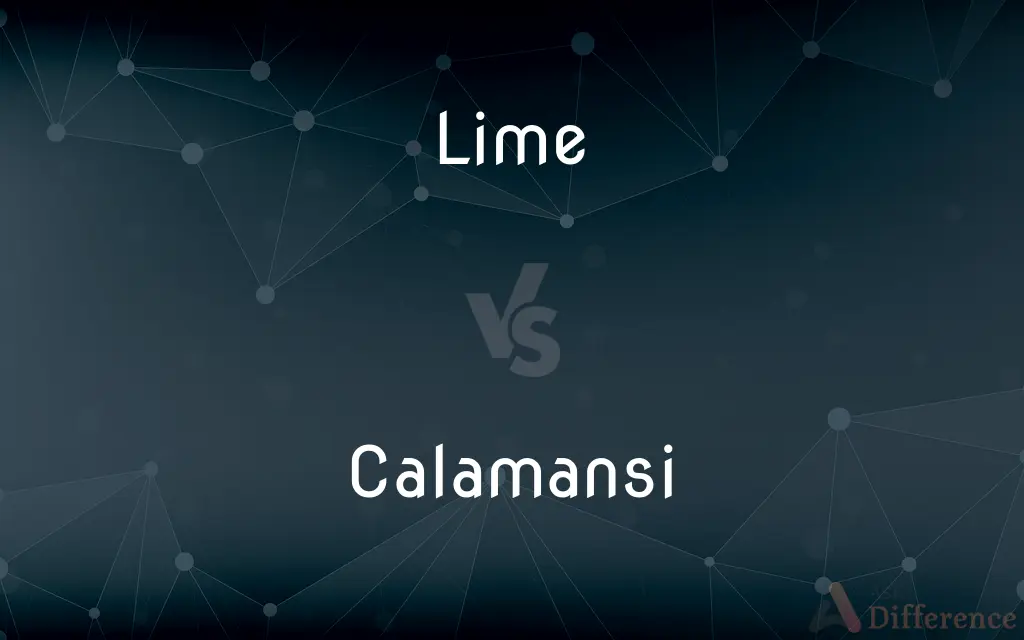Lime vs. Calamansi — What's the Difference?
By Tayyaba Rehman & Fiza Rafique — Updated on March 7, 2024
Lime is a larger, tart citrus fruit widely used globally, while calamansi is smaller, sweeter, and a staple in Filipino cuisine, offering a unique flavor blend.

Difference Between Lime and Calamansi
Table of Contents
ADVERTISEMENT
Key Differences
Limes are a common citrus fruit known for their bright, acidic flavor, making them a staple in culinary applications worldwide. They are larger than calamansi and can vary in color from green to yellow when ripe. On the other hand, calamansi, also known as Philippine lime, is much smaller and typically used in Southeast Asian cuisine, especially in the Philippines. It has a distinctive sweet-tart flavor that is less acidic than a lime.
Limes are versatile, used in everything from beverages and marinades to garnishes and desserts. Their tartness enhances the flavors of various dishes and drinks. Calamansi, while also versatile, is particularly favored in specific applications like calamansi juice, marinades, and as a condiment, offering a flavor that combines the zestiness of lime with the sweetness of orange.
Nutritionally, both fruits are rich in Vitamin C and offer various health benefits, including boosting the immune system and aiding digestion. However, calamansi is also noted for its antioxidant properties and is often used in traditional medicine in the Philippines for its health benefits.
The availability of these fruits differs greatly; limes are readily available in most parts of the world throughout the year. Calamansi, while increasingly available in international markets, is still more commonly found in Southeast Asia and specific ethnic stores outside the region.
In terms of cultivation, limes are grown in warm climates around the world, including the United States, Mexico, and India. Calamansi trees are more often found in the Philippines and other parts of Southeast Asia, requiring similar tropical conditions but on a smaller scale of commercial production.
ADVERTISEMENT
Comparison Chart
Size
Larger
Smaller
Flavor
Tart, acidic
Sweet-tart, less acidic
Culinary Uses
Beverages, marinades, garnishes, desserts
Juice, marinades, condiments
Nutritional Value
High in Vitamin C, aids digestion
High in Vitamin C, antioxidant properties
Availability
Widely available globally
More common in Southeast Asia, ethnic stores
Cultivation
Grown in warm climates worldwide
Primarily grown in the Philippines, Southeast Asia
Compare with Definitions
Lime
Lime is a tart, green citrus fruit used widely in cooking and beverages.
Fresh lime juice adds a zesty flavor to cocktails.
Calamansi
Calamansi is a small, sweet-tart citrus fruit, essential in Filipino cuisine.
Calamansi juice is a popular drink in the Philippines.
Lime
Limes are a good source of Vitamin C and dietary fiber.
Drinking lime water can help improve your digestion.
Calamansi
It combines the flavors of lime and orange, making it unique.
The sweet-tart taste of calamansi enhances the flavor of marinades.
Lime
Limes are cultivated in various warm climates around the globe.
Mexico is one of the largest producers of limes.
Calamansi
This fruit is utilized in various dishes, from beverages to sauces.
Calamansi is often squeezed over noodle dishes for extra zest.
Lime
They are known for their bright acidic flavor that enhances many dishes.
Adding lime zest to a marinade brings out a dish's flavors.
Calamansi
Known for its antioxidant properties, calamansi supports health beyond nutrition.
Calamansi extract is used in traditional Filipino remedies.
Lime
This fruit is versatile, featuring in recipes from savory dishes to desserts.
Lime pie is a refreshing dessert on a hot day.
Calamansi
Calamansi trees are primarily grown in Southeast Asia.
You'll find calamansi trees in many backyards in the Philippines.
Lime
A white caustic alkaline substance consisting of calcium oxide, which is obtained by heating limestone and which combines with water with the production of much heat; quicklime.
Calamansi
Calamansi (Citrus × microcarpa), also known as calamondin, Philippine lime, or Philippine lemon, is an economically important citrus hybrid predominantly cultivated in the Philippines. It is native to the Philippines, Borneo, and Sulawesi in Indonesia in Southeast Asia, as well as southern China and Taiwan in East Asia.
Lime
Birdlime.
Calamansi
Synonym of calamondin
Lime
A rounded citrus fruit similar to a lemon but greener, smaller, and with a distinctive acid flavour
Wedges of lime
Lime juice
Roughly chop two limes
Lime
The evergreen citrus tree which produces limes, widely cultivated in warm climates.
Lime
A bright light green colour like that of a lime
A lime-green bikini
Lime
A deciduous tree with heart-shaped leaves and fragrant yellowish blossom, native to north temperate regions. The pale timber is used for carving and inexpensive furniture.
Lime
An informal social gathering characterized by semi-ritualized talking.
Lime
Treat (soil or water) with lime to reduce acidity and improve fertility or oxygen levels
They were liming acidified lakes
Lime
Catch (a bird) with birdlime
The bird that hath been limed in a bush
Lime
Sit or stand around talking with others
Boys and girls were liming along the roadside as if they didn't have anything to do
Lime
Any of several evergreen trees or shrubs of the genus Citrus having edible green or greenish-yellow fruit, especially the Mexican lime and the Persian lime.
Lime
The fruit of any of these plants, having a pulpy interior and usually acid juice.
Lime
See linden.
Lime
See calcium oxide.
Lime
Any of various mineral and industrial forms of calcium oxide differing chiefly in water content and percentage of constituents such as magnesia, silica, alumina, and iron.
Lime
Birdlime.
Lime
To treat with lime.
Lime
To smear with birdlime.
Lime
To catch or snare with or as if with birdlime.
Lime
(chemistry) Any inorganic material containing calcium, usually calcium oxide (quicklime) or calcium hydroxide (slaked lime).
Lime
(poetic) Any gluey or adhesive substance; something which traps or captures someone; sometimes a synonym for birdlime.
Lime
(theatre) A spotlight.
Lime
A deciduous tree of the genus Tilia, especially Tilia × europaea; the linden tree.
Lime
The wood of this tree.
Lime
Any of several green citrus fruit, somewhat smaller and sharper-tasting than a lemon.
Lime
Any of the trees that bear limes, especially Key lime, Citrus aurantiifolia.
Lime
(uncountable) A brilliant, sometimes yellowish, green colour associated with the fruits of a lime tree.
Lime
A casual gathering to socialize.
Lime
(transitive) To treat with calcium hydroxide or calcium oxide (lime).
Lime
(transitive) To smear with birdlime.
Lime
(rare) To ensnare, catch, entrap.
Lime
(transitive) To apply limewash.
Lime
To hang out/socialize in an informal, relaxed environment, especially with friends, for example at a party or on the beach.
Lime
Containing lime or lime juice.
Lime
Having the aroma or flavor of lime.
Lime
Lime-green.
Lime
A thong by which a dog is led; a leash.
Lime
The linden tree. See Linden.
Lime
The fruit of the Citrus aurantifolia, allied to the lemon, but greener in color; also, the tree which bears it.
Lime
The color of the lime{1}, a yellowish-green.
Lime
Birdlime.
Like the limeThat foolish birds are caught with.
Lime
Oxide of calcium, CaO; the white or gray, caustic substance, usually called quicklime, obtained by calcining limestone or shells, the heat driving off carbon dioxide and leaving lime. It develops great heat when treated with water, forming slaked lime, and is an essential ingredient of cement, plastering, mortar, etc.
Lime
To smear with a viscous substance, as birdlime.
These twigs, in time, will come to be limed.
Lime
To entangle; to insnare.
We had limed ourselvesWith open eyes, and we must take the chance.
Lime
To treat with lime, or oxide or hydrate of calcium; to manure with lime; as, to lime hides for removing the hair; to lime sails in order to whiten them; to lime the lawn to decrease acidity of the soil.
Land may be improved by draining, marling, and liming.
Lime
To cement.
Lime
Having a yellowish-green color like that of the lime (the fruit).
Lime
A caustic substance produced by heating limestone
Lime
A white crystalline oxide used in the production of calcium hydroxide
Lime
A sticky adhesive that is smeared on small branches to capture small birds
Lime
Any of various related trees bearing limes
Lime
Any of various deciduous trees of the genus Tilia with heart-shaped leaves and drooping cymose clusters of yellowish often fragrant flowers; several yield valuable timber
Lime
The green acidic fruit of any of various lime trees
Lime
Spread birdlime on branches to catch birds
Lime
Cover with lime so as to induce growth;
Lime the lawn
Common Curiosities
Which is more commonly used in Filipino cuisine?
Calamansi is a staple in Filipino cuisine, widely used in various dishes.
What's the main flavor difference between lime and calamansi?
Lime is tart and acidic, whereas calamansi offers a sweet-tart flavor that's less acidic.
Are lime and calamansi rich in Vitamin C?
Yes, both fruits are excellent sources of Vitamin C.
Where are lime and calamansi primarily cultivated?
Limes are cultivated worldwide in warm climates, while calamansi is mainly grown in the Philippines and Southeast Asia.
How do the sizes of lime and calamansi compare?
Limes are larger than calamansi, which are small and round.
Can calamansi be used in beverages?
Yes, calamansi juice is a popular beverage in Southeast Asia.
Is lime available year-round?
Yes, limes are available throughout the year in most parts of the world.
What are the health benefits of consuming calamansi?
Beyond Vitamin C, calamansi is known for its antioxidant properties and traditional medicinal uses.
Can you substitute lime for calamansi in recipes?
Yes, but the unique sweet-tart flavor of calamansi may be difficult to replicate exactly with lime.
What makes calamansi unique in its culinary applications?
Its sweet-tart flavor profile makes it versatile for both savory dishes and desserts, unlike the mainly tart lime.
Can calamansi be found in regular grocery stores outside Southeast Asia?
It's becoming more available but is still primarily found in ethnic or specialty stores.
Are there any specific dishes that use calamansi as a key ingredient?
Calamansi is essential in Filipino dishes like pancit, sinigang, and as a dipping sauce mixed with soy sauce.
Are there any desserts made with calamansi?
Yes, calamansi is used in desserts, such as calamansi pie, similar to key lime pie.
How do lime and calamansi contribute to a healthy diet?
They both enhance immune function due to their high Vitamin C content and provide other health benefits.
Is calamansi juice sweeter than lime juice?
Yes, calamansi juice has a sweeter profile due to its unique blend of flavors.
Share Your Discovery

Previous Comparison
Nostalgia vs. Nostalgy
Next Comparison
Ability vs. CapacityAuthor Spotlight
Written by
Tayyaba RehmanTayyaba Rehman is a distinguished writer, currently serving as a primary contributor to askdifference.com. As a researcher in semantics and etymology, Tayyaba's passion for the complexity of languages and their distinctions has found a perfect home on the platform. Tayyaba delves into the intricacies of language, distinguishing between commonly confused words and phrases, thereby providing clarity for readers worldwide.
Co-written by
Fiza RafiqueFiza Rafique is a skilled content writer at AskDifference.com, where she meticulously refines and enhances written pieces. Drawing from her vast editorial expertise, Fiza ensures clarity, accuracy, and precision in every article. Passionate about language, she continually seeks to elevate the quality of content for readers worldwide.















































